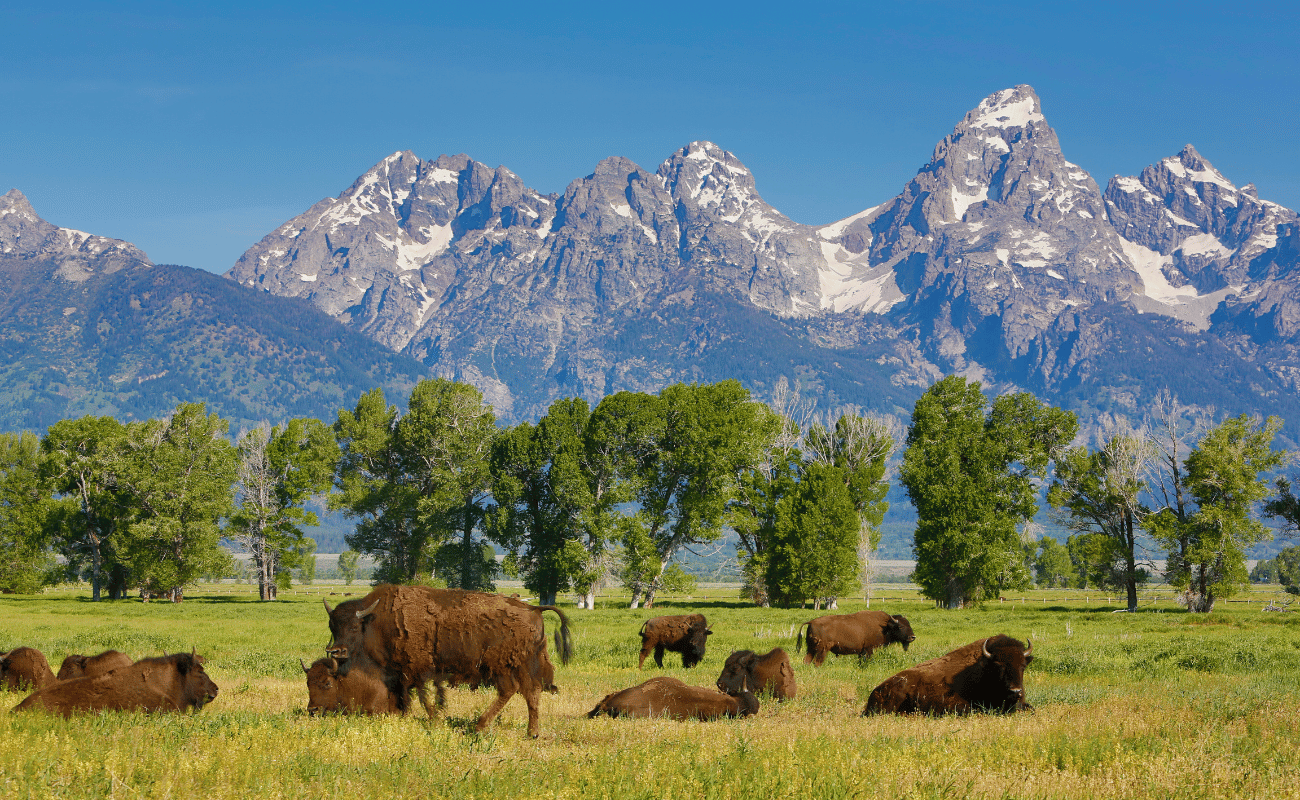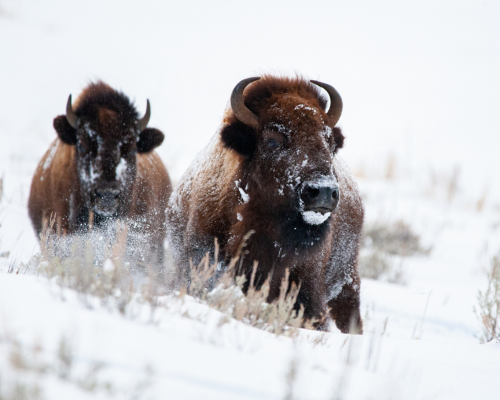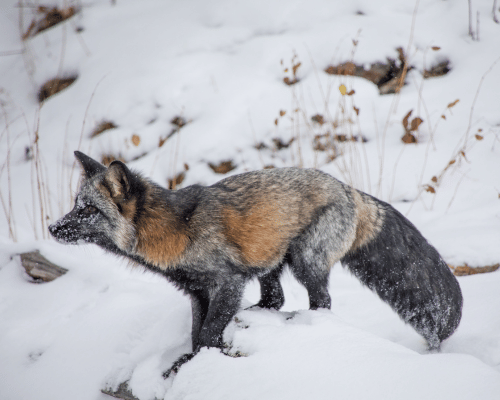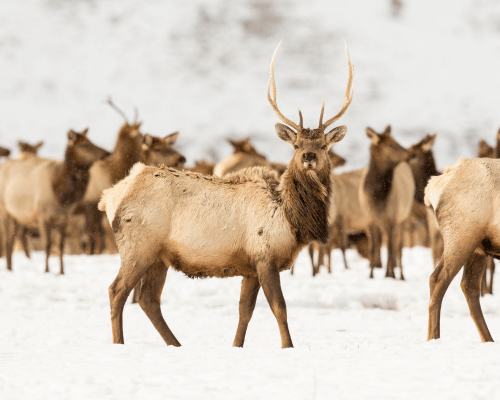The Role of Teton National Park in Wildlife Conservation

Welcome to Teton Wild, your premier tour company for exploring the natural beauty of Teton National Park!
Teton National Park is a breathtaking destination, boasting stunning mountain views, pristine lakes, and a diverse array of wildlife. It is a place where visitors can escape the hustle and bustle of city life and reconnect with nature.
But Teton National Park is more than just a pretty picture. It plays a crucial role in wildlife conservation. With over 310,000 acres of protected land, Teton National Park is home to some of the most iconic species in North America, such as grizzly bears, wolves, and elk.
However, wildlife conservation is not just about preserving cute and cuddly animals. It is about maintaining healthy ecosystems that provide crucial services such as clean air and water, nutrient cycling, and pollination. Teton National Park is a prime example of a healthy ecosystem that supports a diverse array of wildlife, and it is our responsibility to protect it.
We’ll explore the role of Teton National Park in wildlife conservation, from its history and the animals found in the park to the conservation efforts being made and the challenges that lie ahead. Join us as we delve into the fascinating world of Teton National Park and the important role it plays in the conservation of our planet’s precious wildlife.



The Role of Teton National Park in Wildlife Conservation
Safeguarding Biodiversity and Ecological Balance
Welcome to Teton Wild, your premier tour company for exploring the natural beauty of Teton National Park!
Teton National Park is a breathtaking destination, boasting stunning mountain views, pristine lakes, and a diverse array of wildlife. It is a place where visitors can escape the hustle and bustle of city life and reconnect with nature.
But Teton National Park is more than just a pretty picture. It plays a crucial role in wildlife conservation. With over 310,000 acres of protected land, Teton National Park is home to some of the most iconic species in North America, such as grizzly bears, wolves, and elk.
However, wildlife conservation is not just about preserving cute and cuddly animals. It is about maintaining healthy ecosystems that provide crucial services such as clean air and water, nutrient cycling, and pollination. Teton National Park is a prime example of a healthy ecosystem that supports a diverse array of wildlife, and it is our responsibility to protect it.
We’ll explore the role of Teton National Park in wildlife conservation, from its history and the animals found in the park to the conservation efforts being made and the challenges that lie ahead. Join us as we delve into the fascinating world of Teton National Park and the important role it plays in the conservation of our planet’s precious wildlife.
I. History of Teton National Park
Teton National Park was established in 1929, although it had been protected as a forest reserve since 1891. The park covers an area of 310,000 acres and is located in western Wyoming, near the border with Idaho.
Early conservation efforts in Teton National Park can be traced back to the late 19th century when John D. Rockefeller Jr. and other wealthy individuals purchased land in the area to protect it from development. In 1929, Rockefeller donated more than 33,000 acres of land to the federal government to establish the park.
Over the years, Teton National Park has undergone significant changes. In the early years, the park focused primarily on preserving the natural landscape and providing visitors with opportunities for outdoor recreation. However, as the importance of wildlife conservation became increasingly apparent, the park’s focus shifted towards protecting the park’s rich biodiversity.
Today, Teton National Park is a leader in wildlife conservation. It is home to a diverse array of animals, including grizzly bears, wolves, elk, bison, and moose. The park has implemented a range of conservation measures, including research and monitoring programs, habitat restoration projects, and partnerships with local organizations.
Despite the park’s many successes, there are still challenges to be addressed. Climate change, habitat loss, and human-wildlife conflicts all threaten the park’s delicate ecosystems. As we look towards the future, it is important to remember the lessons of the past and work together to ensure that Teton National Park remains a beacon of wildlife conservation for generations to come.
II. Wildlife in Teton National Park
Teton National Park is home to a diverse array of wildlife, including both common and rare species. Some of the animals found in the park include grizzly bears, black bears, gray wolves, elk, bison, moose, bighorn sheep, and mountain goats. The park also hosts a variety of bird species, such as bald eagles, ospreys, and sandhill cranes.
The importance of Teton National Park for wildlife cannot be overstated. It provides a critical habitat for many species, including some that are endangered or threatened. The park’s unique ecosystems, which range from high-elevation alpine meadows to sagebrush flats, support a wide variety of plants and animals.
However, despite its protected status, wildlife in Teton National Park faces a range of threats. Habitat loss and fragmentation, climate change, and human activities such as hunting and development all pose significant challenges to the park’s ecosystems. For example, grizzly bears, which are a keystone species in the park, face threats from habitat loss and fragmentation, as well as conflicts with humans over food sources.
To address these threats, Teton National Park has implemented a range of conservation measures, such as habitat restoration projects, research and monitoring programs, and partnerships with local organizations. Through these efforts, the park is working to ensure that its ecosystems remain healthy and that wildlife populations thrive.
Visitors to Teton National Park play an important role in wildlife conservation. By following park rules and guidelines, such as staying on designated trails and properly storing food, visitors can help minimize their impact on the park’s ecosystems and protect the wildlife that call it home.
III. Conservation Efforts in Teton National Park
Teton National Park is a leader in wildlife conservation, and its efforts to protect the park’s ecosystems and wildlife are diverse and wide-ranging. Some of the conservation efforts being made in the park include:
Research and monitoring programs: Teton National Park conducts a range of research and monitoring programs to better understand the park’s ecosystems and the animals that inhabit them. These programs include tracking wildlife populations, studying animal behavior, and monitoring changes in vegetation.
Habitat restoration projects: Teton National Park has implemented a range of habitat restoration projects to restore degraded habitats and protect critical wildlife habitats. These projects include reseeding native plants, removing invasive species, and restoring wetlands.
Partnerships with local organizations: Teton National Park works closely with local organizations, such as the Greater Yellowstone Coalition and the Jackson Hole Conservation Alliance, to coordinate conservation efforts and leverage resources.
Success stories: Teton National Park has many success stories to share. For example, the park’s wolf reintroduction program has been a major success, with wolf populations rebounding in the park and contributing to a healthier ecosystem. The park has also worked to protect the endangered Canada lynx, and populations of this rare cat have begun to recover in the park.
Despite these successes, there is still much work to be done to protect Teton National Park’s ecosystems and wildlife. The park faces a range of threats, from climate change and habitat loss to human-wildlife conflicts. It is up to all of us to work together to ensure that Teton National Park remains a beacon of wildlife conservation for generations to come.
IV. Challenges in Wildlife Conservation
While Teton National Park has made significant strides in protecting its wildlife and ecosystems, there are still many challenges that need to be addressed. Some of the major challenges facing wildlife conservation in the park include:
Human impact on the park: As the number of visitors to Teton National Park continues to increase, so does the impact of human activities on the park’s ecosystems and wildlife. Activities such as hiking, camping, and off-road vehicle use can disturb wildlife habitats and contribute to habitat loss and fragmentation.
Climate change and its effects on wildlife: Climate change is one of the greatest threats facing wildlife in Teton National Park. Rising temperatures, altered precipitation patterns, and more frequent extreme weather events all contribute to habitat loss and degradation, which can impact wildlife populations.
Balancing conservation with tourism: Teton National Park is a popular tourist destination, and managing the impact of tourism on the park’s ecosystems and wildlife is an ongoing challenge. Balancing the needs of visitors with the needs of wildlife requires careful planning and management.
To address these challenges, Teton National Park continues to implement a range of conservation measures, such as limiting the number of visitors to certain areas of the park and providing education and outreach to visitors on how to minimize their impact on the park’s ecosystems. Additionally, the park is working to reduce its own carbon footprint and increase the use of renewable energy sources.
Ultimately, the long-term success of wildlife conservation in Teton National Park will require the cooperation and support of all stakeholders, including visitors, local communities, and conservation organizations. By working together, we can ensure that the park’s ecosystems and wildlife remain healthy and thriving for generations to come.
V. Future of Teton National Park and Wildlife Conservation
Teton National Park and its diverse wildlife populations are of immense value to our planet. The park has a vital role to play in wildlife conservation, and its future is dependent on continued conservation efforts. To this end, the park has several plans for future conservation efforts, including:
Continued research and monitoring programs to track the health of the park’s ecosystems and wildlife populations.
Habitat restoration projects to restore degraded habitats and protect critical wildlife habitats.
Strengthening partnerships with local organizations to coordinate conservation efforts and leverage resources.
Developing education and outreach programs for visitors to promote sustainable tourism practices and educate them on the importance of wildlife conservation.
Visitors to Teton National Park can also support wildlife conservation by practicing responsible tourism, such as staying on designated trails, properly disposing of waste, and respecting wildlife and their habitats. Additionally, visitors can support conservation efforts by donating to local conservation organizations or volunteering their time and resources to support conservation efforts in the park.
The importance of continuing to protect Teton National Park cannot be overstated. The park’s ecosystems and wildlife are critical components of our planet’s biodiversity, and they provide numerous benefits, including clean air and water, climate regulation, and recreational opportunities. Protecting the park’s ecosystems and wildlife is not only important for the health of the park but also for the health of our planet and future generations. By working together, we can ensure that Teton National Park remains a beacon of wildlife conservation for generations to come.
VI. Conclusion
In conclusion, Teton National Park plays a critical role in wildlife conservation. As one of the most iconic national parks in the United States, it is home to a diverse range of wildlife and ecosystems that need our protection. From the establishment of the park to ongoing conservation efforts, Teton National Park has a rich history of protecting its natural resources and wildlife.
However, there are still many challenges facing wildlife conservation in the park, such as human impact and climate change. These challenges require ongoing conservation efforts and the cooperation of all stakeholders to ensure the park’s ecosystems and wildlife remain healthy and thriving.
As visitors to Teton National Park or supporters of wildlife conservation, we have an important role to play in protecting this valuable natural resource. By practicing responsible tourism, supporting local conservation organizations, and advocating for the protection of wildlife, we can help ensure that Teton National Park remains a vibrant and vital ecosystem for generations to come.
Let us all commit to supporting the ongoing conservation efforts in Teton National Park and work together to protect this valuable natural resource. By doing so, we can help ensure that future generations can continue to experience the wonders of Teton National Park and the magnificent wildlife it supports.




